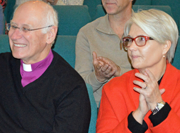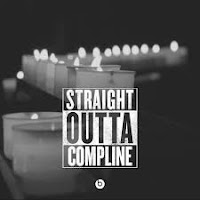Vanishing Vestments?
For nearly a year, I have been researching the use of
vestments and clerical attire within the Pentecostal church. To understand this
issue, we must look deep into the history of our denomination. And by “deep”, I
mean that we must realize that our history pre-dates the birth of
Pentecostalism (as a denomination) in the late 1800s. Many evangelicals (to include Pentecostals)
fall into the trap of not considering church history prior to the mid-1800s. We
tend to form many of our beliefs and values as if we were created in a vacuum
some 1,800 years after the resurrection of Christ. This perspective can tend to skew
our understanding of many “orthodox” practices.
In 1738, John Wesley had a religious experience that led to
the founding of the Methodist Church. Wesley was a priest ordained by the
Church of England (Anglican). Even though he founded the Methodist
denomination, he never left the Anglican priesthood. Regarding the use of
vestments and more orthodox worship styles (responsive readings, etc), people often
relate the Church of England with being traditional, formal or “high”. Sadly,
for that reason alone, many modern evangelicals (including many Pentecostals)
shun ideas such as the use of vestments, clerical collars and orthodox worship
without beginning to understand their history or purpose.
 |
| Pentecostal ministers in Nigeria seen wearing vestments to include a stole. |
It is important to recognize that even as early as the late
1500s, there were some ministers in the Church of England who “insisted on
ministering in their street clothes, or peasant's jacket, and we have record of
one priest who felt that he must wear his hat during the service.” In the 1600s
the Puritans also fought to have the vesting requirements removed. The point
being that the variation of opinions regarding vestments, far predates
Methodism or Pentecostalism and the debate itself appears to have been a holdover
from our Church of England days. I make this point for the benefit of those who
may say that we have departed from the use of vestments due to a perceived rift
with the Anglican or Methodist denominations.
History supports the idea that Wesley and other itinerant
preachers continued to wear at least a robe (alb or pulpit gown) and a stole
and perhaps a preaching collar as well. Speculation is that many itinerant
preachers limited their vestments to those items due to the nature of their
work such as preaching outside and traveling many miles in austere environments.
It stands to reason that Wesley and his contemporaries would “travel light”.
As Methodism began to take root, another problem regarding
vestments and clerical attire arose. Some ministers and preachers were not
actually ordained clergy. As such, it would be improper for them to vest or
wear clerical collars. It is likely that this helped encourage a movement away
from the full accompaniment of vestments as traditionally worn in the Anglican
church (non-ordained folks have always been allowed to wear an alb).
 |
| Pentecostal Bishop Charles Blake (CoGIC) wearing a clerical collar and vestments consistent with his office. |
Regarding clerical collars and their presence (or absence)
from Pentecostal denominations, we must delve into another history lesson. The tabbed
or banded collar itself began in secular fashion perhaps as early as the late
1500s. The clergy collar, as we know it, was invented by the Presbyterians (and
you thought it was a Roman Catholic thing). Some form of clerical collar became
a mainstay by the mid to late 1800s firstly for Protestants and then Catholics
alike, but only for those who were formally ordained or licensed. The tradition
of clergy wearing collars was also adopted by the Methodist church in both England
and in the United States. In the early 1800s, many Anglican clergy chose to
identify themselves by wearing a white shirt and black tie.
In the late 1800s and early 1900s, what we know as the
Pentecostal church (in very general terms) came into existence. Most of what we
know as Pentecostalism comes from a shift in doctrinal emphasis from traditional
Methodist teaching. Much like Wesley’s Methodist movement, this created an
environment where many lay (non-ordained) ministers and preachers began to serve.
Regardless of whether the individual decided (or was forced) to leave the
Methodist church, laity could not justifiably wear a clergy collar. No doubt
this contributed significantly to collars going out of fashion in the newly
thriving Pentecostal circles. As a means to identify themselves in public, it
is interesting to note that in the early 1900s, many Pentecostal ministers and
preachers chose to return to the white shirt and black tie concept that was
once common in the Church of England 100 years prior. As the general clothing
recommendations and requirements of Pentecostal (to include Holiness) churches
loosened, the white shirt and black tie suggestion also faded away.
 |
| General Superintendent of the IPHC Doug Beacham is pictured here wearing a clerical collar and purple shirt consistent with the office of bishop. |
So, what does it all mean? We have discussed two points in
history where a shift (not an outright change) in doctrinal beliefs lead us to
where we are today. The first was John Wesley’s Methodist movement. Wesley
himself said that he believed his movement fit well within the doctrinal bounds
of the Church of England and in fact the Church never renounced his Holy Orders
seeming to indicate that it, although somewhat begrudgingly, agreed. Wesley did
lose favor with many parish (local) level clergy and churches and he was
prohibited from teaching in some places because doing so encroached upon the authority of the local church. To fully understand this, you must understand
the politics and functioning of the Church of England as a “state” church. By
most accounts, there was not a great doctrinal split that many (to this day) assume
occurred. Wesley never left the Anglican church, nor was he ejected. There is
no historical evidence to support the idea that Wesley’s doctrinal emphasis (allowing
the Methodist church to arise) caused modern Pentecostals to devalue, prohibit
or move away from the wearing of vestments or recognizing the liturgical year
or any other orthodox practice.
The second, and perhaps more profound, time that a shift in
doctrinal emphasis occurred was with the creation of Pentecostalism as a
derivative of the Methodist church in the late 1800s. A lot went on here, but
what did not occur was a renunciation of the liturgical practices (such as the
church calendar) nor of the use of vestments or clerical clothing. For many,
the departure from these things did occur, but they did so as a matter of
function or choice, not a matter of doctrine. There are some who hold strong
opinions that when we (Pentecostals) left the Methodist church we did so
partially to leave behind supposed “high church” ideals such as the liturgical
calendar, vestments and clerical attire. While some continue to hold strong
opinions on these subjects, the evidence simply does not bear it out. We do
know that there was an abandonment of responsive readings, prayers and the like
because many felt that those things focused too much on “word and sacrament”
and not enough on the movement of the Spirit. It is important to note however
that the Pentecostal church did not and has not ever renounced the use of
liturgical practices or vestments and in fact, now more than ever, supports a
diversity of worship styles.
 |
| A newly ordained Pentecostal minister in Europe receives his collar. |
In conclusion, I know of no Pentecostal
doctrinal guides (such as the IPHC manual) that prohibit the use of vestments
(particularly albs, pulpit gowns or stoles), clerical attire (such as collars),
the liturgical calendar, or even more orthodox practices (such as responsive
readings and recited prayers). With there being no guiding statements within
our own cannons, one could refer to the Methodist tradition which certainly
allows for vestments, collars and liturgical celebrations. In the IPHC, we,
particularly as ministers, are doctrinally free to dress (and vest) how we see
fit in order to fulfill our calling. My call to you is to consider understanding and tolerance in these areas regardless of your personal choices, because after all....they are just choices.
Look for future blog posts on the meanings behind the wearing of certain vestments and the more orthodox/liturgical practices.
Grace and Peace.
Grace and Peace.
References:
Clemens, Theo H.J.; Janse, Wim (19 October 2009). "The
Pastor Bonus: Papers Read at the British-Dutch Colloquiumat Utrecht, 18–21
September 2002"
Collins, Rev. Kenneth W. (19 October 2009). Vestments and
Clericals. Hemera Technologies, Inc
Daniels, L. E.
(n.d.). The Ornaments Rubric: Its History and Force. Anglican Society.
Synan, V. (1998). Oldtime power: A centennial history of the International
Pentecostal Holiness Church. Franklin Springs, GA: LifeSprings.
The Ornaments
Rubric and How It Was Interpreted in the Elizabeth Church. (2011, August 10).
Retrieved August 27, 2018, from http://thehackneyhub.blogspot.com/2011/08/ornaments-rubric-and-how-it-was.html
Tribe, S.
(2006). New Liturgical Movement: On the Origins and Development of Vestments.
Part I: Origins. New Liturgical
Movement.
Wray, C. D.
(1856). A Short Inquiry Respecting The Vestments of the Priests of the Anglican
Church And Whether The Surplice Or Black Gown Should Be Worn During The Sermon.


Comments
Post a Comment